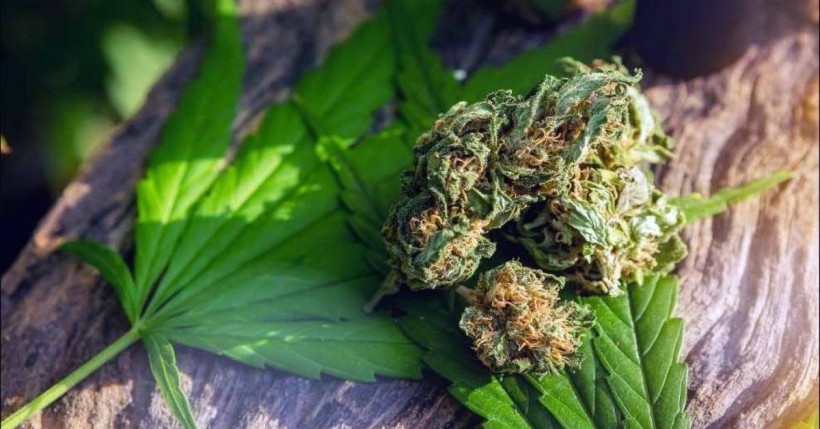Can Cannabis Kill Cancer Cells And Be An Effective Cancer Cure?
Warning: Undefined variable $post in /home/dietofli/public_html/wp-content/plugins/code-snippets/php/snippet-ops.php(584) : eval()'d code on line 3
Warning: Attempt to read property "ID" on null in /home/dietofli/public_html/wp-content/plugins/code-snippets/php/snippet-ops.php(584) : eval()'d code on line 3
The estimated reading time is 10 minutes
Warning: Undefined variable $post in /home/dietofli/public_html/wp-content/plugins/oxygen/component-framework/components/classes/code-block.class.php(115) : eval()'d code on line 3
Warning: Attempt to read property "ID" on null in /home/dietofli/public_html/wp-content/plugins/oxygen/component-framework/components/classes/code-block.class.php(115) : eval()'d code on line 3

Marijuana, weed, hemp? There are so many different names for cannabis, including more than 1,200 slang terms and more than 2,300 names for individual strains, but the earliest name for this plant is the Chinese one.
Ma, is the Chinese name for hemp, the plant that was used for medical purposes in China in 2700 BC and it is the oldest known name for this plant. Cannabis is the Latin, or the scientific name, and most commonly used.
Cannabis is mainly used for pleasure or recreation, but a growing number of doctors prescribe it for several health conditions. There is a widespread belief that it is an effective treatment for various diseases. Even though there is a lack of scientific evidence, recently, there has been a forced drive that urges its legalization.
As of February 2022, its use for medical purposes is legalized in 37 American states and in the District of Colombia. (1)
Cannabis The Most Commonly Cultivated Drug Worldwide
Cannabis is the most commonly cultivated, trafficked, and abused illicit drug worldwide. It is a generic term used to designate several psychoactive preparations of the plant Cannabis sativa. The main psychoactive constituent in cannabis is ∆-9 tetrahydrocannabinol (THC). All other similar constituents are called cannabinoids that interact with specific receptors in the nervous system and regulate how cells communicate, send and receive messages.
The Mexican term "marihuana", "mariguana" is used in many countries for the indication of the plant leaves and crude plant material. The female plants that are not pollinated are called hashish.
About 19 % of Americans used marijuana at least once in 2019, as shown in the National survey on drug use and health. (2)
Why Do People Use It?
Its main psychoactive constituent, THC, stimulates the part of your brain that responds to pleasure and releases a chemical compound called dopamine and the euphoric effect may be felt immediately if smoked or vaporized.
If eaten, the effects are not immediate, and you will start feeling high in an hour or two.
The general effects of consuming cannabis are:
- feelings of well being
- euphoria
- increased appetite
- spontaneous laughter and excitement
- dry mouth
- quiet and reflective mood
Cannabis Side Effects
On the other hand, some people may have unpleasant feelings after using it and feel panic, paranoia, and increased anxiety. Its use can even increase your chances of getting depression.
In addition, when taken in very high doses, you might lose touch with reality and start hallucinating.
Actually, the side effects of this drug have been recognized for years and are scientifically confirmed. They can be summarized as follows:
- Time distortion
- Impaired psychomotor performance (increased chances of motor vehicle accidents)
- Addiction (even physically dependent on it and feeling restless and irritable, unable to eat and sleep)
- Lungs inflammation (injury of the trachea and impaired pulmonary defense, chronic bronchitis)
- Impaired cognitive development
- Impaired fetal development during pregnancy and postnatal risk of rare forms of cancer
- Increased risk for the slow-growing seminoma subtype of testicular cancer
Cannabidiol (CBD) Benefits
Nevertheless, cannabis's compound Cannabidiol (CBD) is not psychoactive as its main ingredient THC. This quality makes him an appealing option for people who suffer from pain and it was used as a medicine to treat pain since 2900 B.C. (3)
Cannabidiol (CBD) is also proved to be beneficial for people with neurological disorders such as epilepsy and M.S. Still, additional research is needed on its potential effectiveness for these health conditions.
In addition, several studies were made to investigate its benefits on the heart and circulatory system and its ability to lower high blood pressure with promising results. (4)
Even though it sounds paradoxical, some studies proved it with small evidence to relieve depression and post-traumatic stress disorders. (5) It is advertised as a reliever, and the CBD industry is flourishing this plant extract is added to breathe sprays, gels, toothpicks, and cheeseburgers as it is relatively safe.
How Can Cannabis Affect Symptoms Of Cancer And Cancer Cells?
Cannabis sativa L. (marijuana) has been used for medicinal and recreational purposes for many centuries.
However, the chemical structures of its components—the cannabinoids—were more thoroughly explained even in the 1960s. More research was conducted 3 decades later and that provoked an impressive expansion of cannabinoid research in many fields, including cancer studies. Nowadays, it is confirmed that out of 108 cannabinoids that C. sativa produces, THC is the most important due to its high potency and abundance when it comes to its effectiveness.
Why Do Cancer Patients Use It?
Cannabis has been used medicinally and recreationally for hundreds of years.
Although the research has shown mixed results, some studies have shown that some cannabinoids have the ability to:
- reduce inflammation
- reduce the cancer spread
- kill cancer cells
- block cell growth
- stop the development of blood vessels – needed for tumors to grow
Scientists also discovered that cannabinoids are able to:
- sometimes encourage cancer cells to grow
- harm crucial blood vessels
Does Cannabidiol (CBD) Kill Cancer Cells?
It was proved that Cannabidiol (CBD), one of its main components, can reduce and alleviate some cancer–related symptoms such as nausea and vomiting in some cancer patients. (6)
When it comes to killing cancer cells, some studies have reported that chemical compounds found in cannabis can kill cancer cells, but these were animal studies and did not involve humans.
The Food and Drug Administration in the United States has approved products based on cannabis for the treatment only of side effects related to cancer. These products are not proven to cure cancer.
Clinical Studies For Cannabinoids Related To Cancer
Many studies were conducted to investigate the relation between cannabinoids and cancer but haven't proven any relevant scientific evidence that can effectively treat cancer.
Still, the research is going on, and some studies have found promising results.
The most promising results come from using a combination of purified THC and cannabidiol (CBD) and from a receptor called JWH-133. (7)
Few studies were conducted to test the benefits of cannabinoids with cancer patients with glioblastoma multiforme (GBM), the most aggressive type of cancer that begins within the brain.
In one study, highly purified THC was given to 9 patients directly into their brain with a tube, and it was proved to be a safe method. It was an early stage trial and there was no control group, so it did not show any promising results. (8)
In 2021, in one study, cancer patients were treated with recurrent glioblastoma multiforme (GBM) with Sativex (medical cannabis) in combination with the chemotherapy drug temozolomide. The patients showed considerable side effects such as headache, vomiting, dizziness, and nausea. Still, 83 % of patients who were treated with Sativex were alive one year after the treatment compared to those who took a placebo (44%). But, unfortunately, this study involved only 27 patients. This number is not sufficient to confirm the benefits of Sativex. It was conducted to show only if it is safe for the patients.
One study conducted in 2021 also found that extracts from the cannabis plant protect normal colon cells while reducing the capability of cancerous cells. (9)
A three-year study was recently conducted at the University of Newcastle in collaboration with Hunter Medical Research Institute. They investigated a specific and modified form of medical cannabis with high levels of the compound cannabidiol (CBD and low levels of THC).
It was found that the enriched and modified variety was more successful at killing cancer cells than the THC variety when treating leukemia and pediatric brainstem glioma. (10)
Even though these are promising studies, according to the journal Clinical Pharmacology & Therapeutics, there is no solid base to claim that it can cure cancer. (11)
Cannabis Immunomodulatory Properties
In addition, it has potent immunomodulatory properties and can be used simultaneously with immunotherapy. One study evaluated the influence of cannabis use during the immunotherapy treatment on response rate (R.R.), progression-free survival (PFS), and overall survival (O.S.) and it was found that it did not affect the PFS or O.S., but decreased R.R. The study was limited and additional research is needed. (12)
Cannabis used for cancer prevention
In some studies and in a few experiments, high doses of purified THC were given to mice and showed that they have lower risks of developing cancer, but more research is needed to confirm this claim and to prove that endocannabinoids can suppress tumor growth.
Cannabinoid Drugs
2 drugs based on cannabis compounds are approved in the United States for medical use.
- Dronabinol (Marinol®) is used to control nausea and vomiting in cancer patients. It is a gelatin capsule composed of THC, FDA approves that) for the side effects of cancer chemotherapy as well as for weight loss and poor appetite in patients who have AIDS.
- Nabilone (Cesamet®) is another synthetic drug based on cannabis compounds that have similar capabilities to THC. It can be taken for treatment of the side effects of cancer chemotherapy, such as vomiting and nausea, if other treatments did not show any positive impact.
If you take cannabis products and drugs based on cannabis compounds, you may feel drowsy, sleepy, have increased heart rate or nausea, or blood pressure change.
How Cannabis Oil Works To Kill Cancer?
Many types of cannabis oil are sold online and in some shops, such as health food shops.
Cannabis oil can contain different quantities of THC and CBD. The oil, when in pure form does not contain THC, so consequently does not affect your nervous system and does not have any psychoactive effects.
Some potential medical benefits of CBD oil are relief from stress and anxiety and pain relief for both chronic and muscle pain. In addition, CBD can even have neuroprotective effects.
Some extraction methods are isolates extraction, alcohol extraction, or CO2 extraction. Its power can differentiate depending on the source and on the extraction method. The extraction from a plant rich in CBD is believed to have the highest production of cannabinoids.
When extracted in high doses, its potency is greater and can interact with the body's endocannabinoid system. This system is responsible for the regulation of different body functions such as sleep, energy, mood, behavior, and much more. Moreover, it is responsible for apoptosis and cell growth.
Considering that cancer is formed from abnormal cell formation, cannabis oil may help kill the abnormal cancer cell, especially in the early stages of cancer.
The American Cancer Society
The American Cancer Society encourages the need for additional scientific research on cannabinoids for cancer patients. In addition, it recognizes the need for better and more effective therapies that can overcome the side effects of cancer and its treatment that often cause severe impairment.
Conclusion:
- Cannabis is the most commonly cultivated, trafficked, and abused illicit drug worldwide and has been used for medicinal and recreational purposes for many centuries.
- Many studies were conducted to investigate the relation between cannabinoids and cancer but haven't proven any relevant scientific evidence that can effectively treat cancer. But, it was confirmed that Cannabidiol (CBD), one of its main components, can reduce and alleviate some cancer–related symptoms such as nausea and vomiting in some cancer patients.
- The American Cancer Society encourages the need for additional scientific research on cannabinoids for cancer patients as some studies have shown some promising results.














